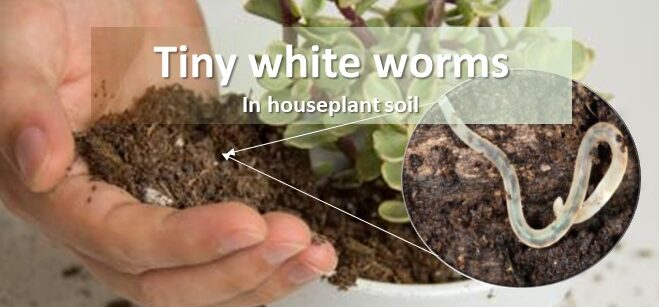Pot worms, Grub worms, Gnats larvae or even Nematodes can be tiny white worms in houseplant soil. Are you thinking about how these tiny white worms come into your indoor plant soil? Can they damage your houseplant? How to get rid of them? Join me here to tell you all the things you should know about the tiny white worms in plant soil.
Hi, I’m a horticultural consultant (I have a PhD in plant protection science) and here, I want to answer one of the common concerns of gardeners: Tiny White Worms in Plant Soil. People often ask me “What are these small white worms in the soil?” and more questions about them. In this post:
- First, I will discuss four common tiny white worms that I often spot in potted plant soil. I also will show you their images to make their identification easy for you.
- Then, I will tell you how they enter your houseplant soil and the conditions that cause increasing their population. This information will help you to design a perfect strategy to control them.
- Finally, based on the above information, I will show you how to prevent tiny white worms in the soil and get rid of them.
So, let’s get going.
➡ You can also hear the audio version of this article.
Four Common Tiny White Worms in Houseplants’ Soils

Based on my experiences, most reports of tiny white worms in plant soil belong to one of the four groups:
- Nematodes
- The larva of gnats
- Pot worms
- Grub worms
I found the above worms in various sizes for example some of them are so tiny such as nematodes and seeing them to the naked eye is unlikely. On the other hand, some white worms in potted plants such as pot worms are visible to the naked eye easily.
Keep reading to give you an overview of tiny white worms in houseplant soil.
1- Nematodes in Houseplant Soils
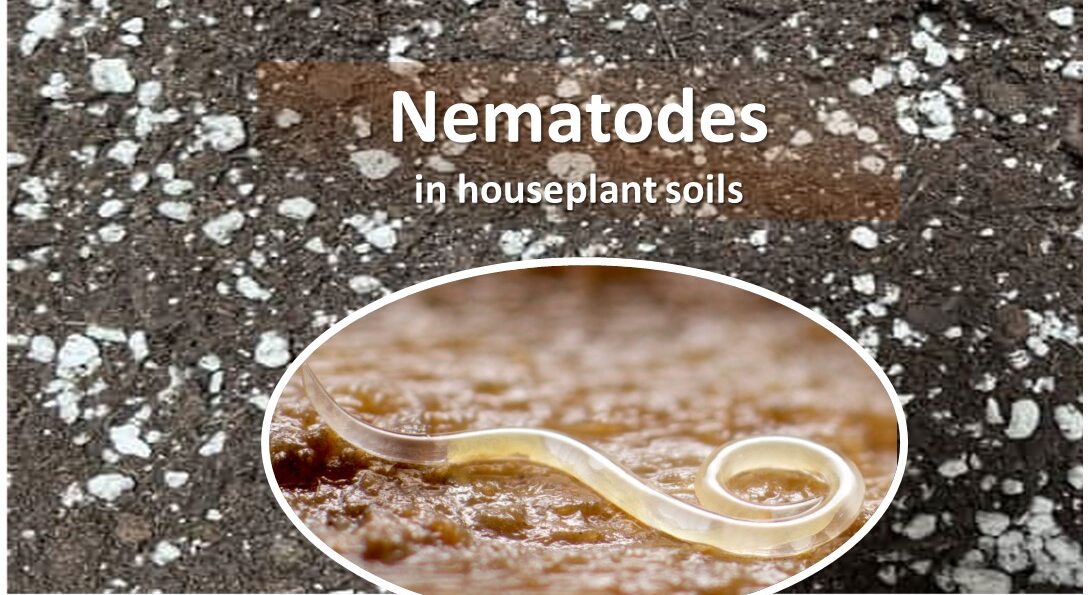
Some gardeners get very curious when spotting the pot’s soil with their magnifying glasses or even their simple binoculars. You can see the image of nematodes in houseplant soil above. People often ask me what is these so tiny white worms in plant soil. Are they harmful to my houseplant?
I always answer them these are nematodes and you have to be worried about them if you spot the following things:
- ➡ The symptoms like weakness, slow growth, yellowing, wilting and decline in your houseplant which you cannot solve with fertilizers,
- ➡ The signs such as gall or sore on roots without any symptoms of root infesting bugs.
If you are not familiar with the symptoms of tiny bugs that attack your houseplant roots, read “The 6 common tiny bugs in houseplant soil“ and identify culprits by their images and symptoms!”
Otherwise, the nematodes are harmless. A lot of various nematodes live inside soil and only a few of them are plant pathogens. Some nematodes can help you to have lusher houseplants by:
- Improving air circulation inside the soil and drainage. It is very critical for root growth.
- Help to produce compost inside the soil through the vermicomposting process.
- They play a critical role in the biological control of some pests, for example, Nematodes for fungus gnats.
So, they can be your new friends and you should leave them to do their things.
2- The Larva of Gnats: Tiny white worms in plant Soil
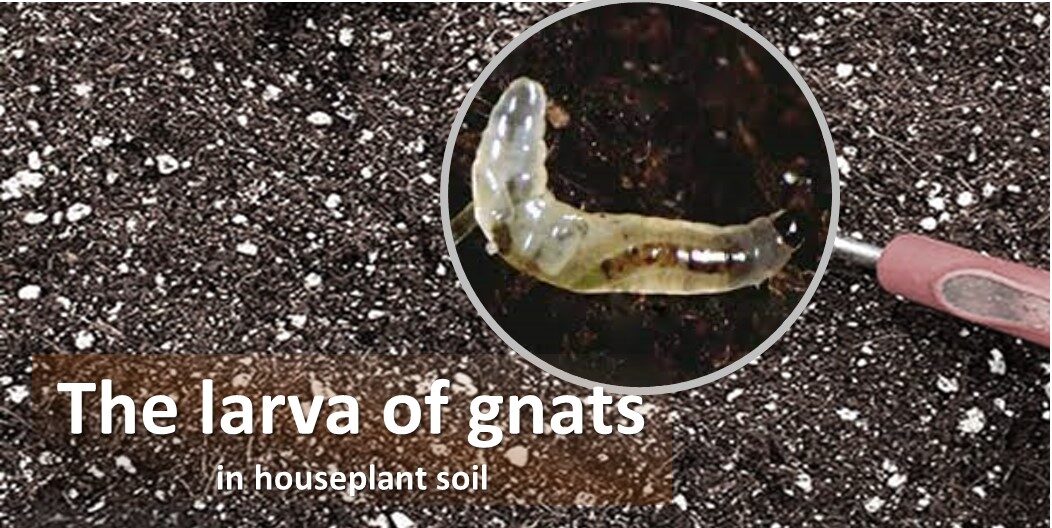
I found out that one of the common reports of tiny white worms in houseplant soils is related to the larva of gnats especially “Fungus Gnats”, although they are not real worms. In the above, you can see the image of “Fungus Gnats” and their larva.
If you spot the Fungus Gnats while are flying around your indoor plant, you have to be concerned about their larva inside the soil of your potted plant. They lay their eggs inside the soil and their tiny white worm-like larva will hatch after four days. These tiny larvae are about 8 mm and have a black head.
➡ The larva feeds off the roots of your houseplant until converts into a fly and causes critical damage to potted plants.
3- Pot Worms: Tiny white worms in plant Soil
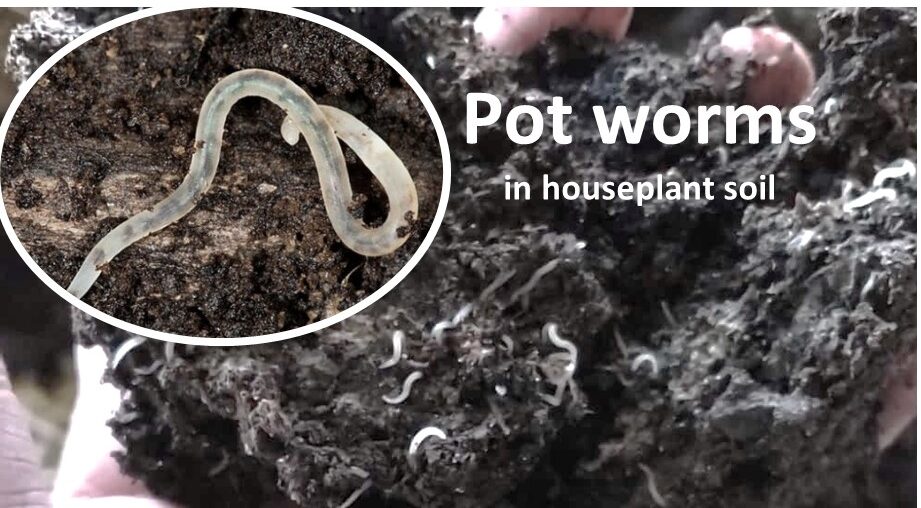
based on my experiences most gardeners see pot worms in the soil of potted plants. They are tiny white worms in plant soil similar to earthworms but much smaller and pale whitish. In the above, you saw the tiny white pot worms.
Pot worms in small numbers are beneficial for potted plants because:
- They feed on organic matter and convert them to compost.
- They improve soil aeration which is critical for root systems.
- They usually feed on fungal hyphae and bacterial material.
Sometimes the population of tiny white pot worms increase and you will spot them in large groups while they are moving in your houseplant soil. Some reports say in huge populations, the pot worms can be harmful to your houseplant by competing with useful soil worms such as red wigglers (Eisenia fetida). The red wigglers are one of the critical members of producing compost inside the soil.
4- Grub Worms: Small White Worms in Soil
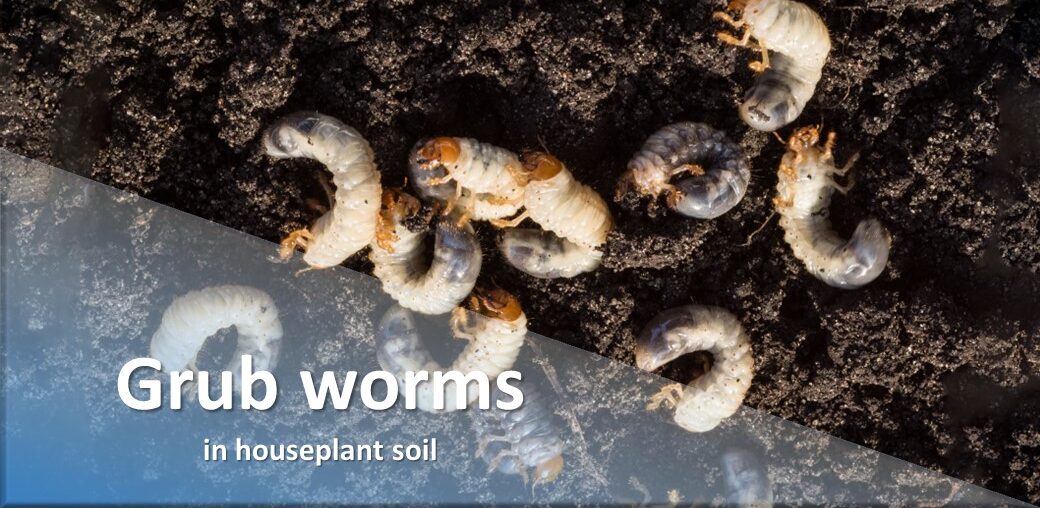
Grub worms are not real worms. Indeed, they are the larvae of different beetles that live inside the soil until convert to beetles and leave there. The grub worms are usually nearly 2 inches in length with white to cream bodies and darker heads. In the below, you can see them. they are very ugly, they aren’t?
The grub worms feed off the roots of your houseplant and some adults will feed on leaves. Hence if you spot them in the soil, collect them from the soil easily and eradicate them quickly before harming your houseplant.
How Do the Tiny White Worms Enter the Houseplant’s Soil?
The nematodes and pot worms usually live inside the soil but some conditions that will be mentioned in the following will cause their population to increase suddenly. But the larva of gnats and grub worms enter the house of your potted plant when the adults lay their eggs inside the soil.
however, all white tiny worms can enter the soil of your indoor plant by adding infested soil or compost to the soil.
How to Increase the Tiny White Worms’ Population in Houseplant Soil.
In the following, you can find out three important factors that generally will increase the population of tiny white worms in the soil of potted plants. This information will help you design a good strategy to kill or control them.

- Changing the PH of the soil alkaline, will promote the growth of tiny white worms in the soil.
- Most worms love over-watering, moist soil and a humid environment to increase their population.
- Rich soils with a lot of organic materials are the favourite habitat for most tiny white worms in houseplant soils.
How to Get Rid of Tiny White Worms in Houseplant Soil?
If you want to control or kill tiny white worms, follow the below tips.
- Remove your potted plant from the soil.
- If you spot grubworms, the easiest way is to collect them and then eradicate them. Be careful about the adult beetles, try to find and kill them to prevent them from lying in the soil again.
- You can easily control the population of grub worms and gnat larvae by removing the topsoil. Most of them usually gather in topsoil.
- Biological control is an environmentally friendly way to control grub larvae and fungus gnat larvae. For example, the bacterium Bacillus thuringiensis can be very effective against them.
- Soil drenching with neem oil can be an effective strategy to control most worms, fungus gnat larvae, grubs and tiny bugs in the houseplant soil. Read “How to make neem oil spray” to tell you all the things you should know to make and use this magic natural pesticide.

- If your houseplant can stand the dry condition, decreasing the moisture of the soil and humidity of the environment will decrease the population of tiny white worms in your indoor plant soil.
Conclusion
Now you found out the tiny white worms in the soil of your houseplant most likely are nematodes, larvae of gnats, pot worms or grub worms. In addition, I told you what is their favourite condition and how to get rid of them.
Did this article help you to identify your tiny white worms in houseplant soil? Have you seen a tiny white worm that was not mentioned in this article? Do you think the above remedies will work well to get rid of them? Do you have your specific treatment?
💡 Please notice if you didn’t win in identifying your tiny white worms, take a clear close picture of them and send me (inhouseplant2017@gmail.com) to help you. Please share your ideas and experience below this page.

Elahe Rabiei
Hi, I’m Elaheh. My Academic major is plant protection, and houseplants are my expertise. As a houseplant lover, my house is full of indoor plants and it is my passion to take care of them. Hence, I’m here to share my knowledge and experience about growing healthy houseplants. I am also a plant protection advisor, so feel free to ask me any questions you may have.

